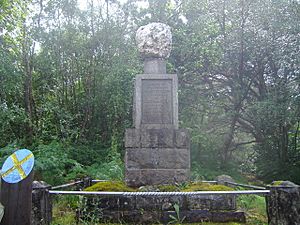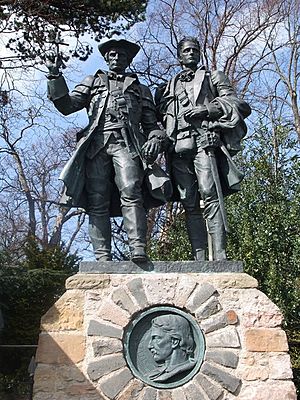Appin Murder facts for kids
Quick facts for kids Appin Murder |
|||||||
|---|---|---|---|---|---|---|---|
| Part of the aftermath of the Jacobite rising of 1745 | |||||||
 Memorial to James Stewart of the Glens who was wrongly convicted and executed for the Appin murder |
|||||||
|
|||||||
| Belligerents | |||||||
| Commanders and leaders | |||||||
| Casualties and losses | |||||||
| Colin Roy Campbell of Glenure killed | James Stewart executed Allan Stewart exiled |
||||||
The Appin Murder (Scottish Gaelic: Murt na h-Apainn) was a famous killing in Scotland. It happened on May 14, 1752, near Appin in the west of Scotland. The victim was Colin Roy Campbell, a land manager for the government. He was shot because of his role in forcing people off their land.
This event took place after the Jacobite Rising of 1745, a rebellion where people tried to put a different king on the throne. The murder led to James Stewart of the Glens being put to death. Many people believe he was wrongly accused. The Appin Murder also inspired parts of Robert Louis Stevenson's famous novels, Kidnapped and Catriona.
Contents
Who Was the Victim?

Colin Roy Campbell of Glenure (1708-1752) was known as "The Red Fox." He worked for the government as a land manager, or factor. His job was to manage lands that had been taken from the Clan Stewart of Appin. These lands were taken after the Jacobite rebellion.
During this time, many people were forced to leave their homes. This period is known as the Highland Clearances. Campbell ordered many families from the Stewart clan to leave their land. He replaced them with members of his own clan, the Campbells. This went against an old rule that said clan members had a right to live on their clan's land.
On May 14, 1752, Campbell was on his way to make more families leave their homes. He was shot in the back by a skilled shooter in the woods near Duror. He was with three other people, including his nephew. After being shot, Campbell cried out, "Oh, I am dead - take care of yourselves." His nephew saw a person in dark clothes with a musket on a nearby hill.
The Trial and Its Outcome
After the murder, the search for the killer focused on the Stewart clan. The main suspect, Allan Breck Stewart, ran away. Because Allan fled, James Stewart of the Glens was arrested. James was a leader in the Stewart clan.
James was put on trial for the murder. The trial was heavily influenced by the Campbell clan, who supported the current government. The main judge was Archibald Campbell, 3rd Duke of Argyll, who was the chief of the Campbell clan. Also, 15 people on the jury were from the Campbell clan.
Even though James had a strong alibi (proof he was somewhere else), he was found guilty. He was found guilty of helping plan the murder, even if he didn't pull the trigger himself.
James Stewart was hanged on November 8, 1752. He was hanged on a special gallows near Ballachulish. He said he was innocent until the very end. His body was left hanging for 18 months as a warning to other clans. Over time, his bones were held together with chains.
New Ideas About the Murder
For many years, people have wondered who really shot Colin Campbell.
In 2005, a writer named Ian Nimmo looked at the old documents about the case. He used modern police methods to study them. Nimmo believes that Allan Stewart did not do the shooting. He said that the real killer's identity has been a secret in the Stewart family for 250 years. Nimmo chose not to share the secret.
In 2001, an 89-year-old woman named Amanda Penman shared a new idea. She was a descendant of the Stewart clan chiefs. She said that four young Stewart men planned the murder without James of the Glens knowing. She believed the best shooter among them, Donald Stewart of Ballachulish, was the one who fired the shot. Some stories say Donald wanted to turn himself in to save James, but others stopped him.
In 2004, Lee Holcombe also looked at the evidence. He agreed that Donald Stewart of Ballachulish was likely the shooter, not Allan Breck Stewart. However, Holcombe also thought that James of the Glens, despite saying he was innocent, probably did order the murder.
Efforts to Clear James Stewart's Name
Today, some people are trying to get a pardon for James of the Glens. A pardon would officially clear his name.
In 2008, a lawyer named John Macaulay asked the Scottish Criminal Cases Review Commission to look at the case again. He said there was "not a shred of evidence" against James Stewart in the trial records. However, the commission said they would not review the case because it was too old. As of 2010, the request for a pardon is with the Scottish government.
See also
- William Grant, Lord Prestongrange the chief prosecutor.
- Keppoch murders

